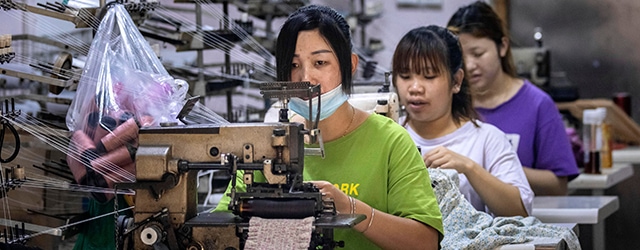China’s government is using loans, tax deferments, rent reductions and even sales leads to help smaller enterprises—“capillaries of the market economy”—survive Covid-19.

They are the “other” Chinese economy: millions of small and medium-size enterprises (SMEs) that manufacture, transport and trade outside the special comfort zone in which powerful state-owned companies enjoy government support. Now, they are moving into the spotlight.
The People’s Bank of China in June launched an unprecedented program through which village banks, rural credit unions and other smaller financial institutions receive special incentives to defer loan and interest payments for SMEs due between at least December 31, 2020 and with an extended repayment period until March 31, 2021.
Meanwhile, the State Council (the chief administrative authority) unveiled a plan to funnel some $282 billion to cities and counties for programs designed to help local SMEs and other businesses “most affected” by the pandemic. Premier Li Keqiang has also urged ecommerce platforms to help SMEs explore new markets.
Local governments are lending a hand as well. Already in February, the city of Beijing rolled out a 16-point small-business support program that cut some commercial rents in half. In Shanghai, the Shanghai Pudong Development Bank waived rent payments for SMEs for at least two months.
David Xu is one of many small entrepreneurs benefiting from government support while also hustling for business. He runs a 12-person logistics company, Sino Projects, which specializes in transporting Chinese-made heavy machinery to Russia, Mongolia and Central Asia.
“The government has given us a lot of strong SME support, such as reducing social security [payments], reducing rent, delaying or even reducing some taxes, providing low-interest
Adjustments
The company has had to make extensive adjustments since the Covid-19 outbreak began. “We all work from home; projects have been postponed or canceled, the port is closed, shipping companies have reduced the number of ships,” says Xu. “It’s had a huge impact on us.”
So far, he has managed to adapt and weather the storm. “In March, we urgently launched a new business focusing on exporting epidemic-prevention materials such as masks, protective clothing and thermometer guns,” Xu says. Sino Projects has “also actively expanded into the air transportation business.”
Another scrambling SME owner is Yan Zhang, whose 18-employee Beijing Art Space Expo Services builds company display booths for international trade exhibitions. The company faces formidable challenges that could stretch well into 2021.
“The situation has not been good,” Yan says. “Our domestic business basically stopped in January, and at first the European and American markets were not affected. Then starting in late February, Europe, the US and Japan were successively affected by Covid-19. All of our business basically stopped. Our biggest challenge is to survive.”
Yan’s company is taking advantage of government support while exploring new business areas and hoping trade exhibitions will resume next spring.
A government website touting Covid-19 aid for businesses calls SMEs “capillaries of the market economy.” It adds, “We must do everything possible to help small, medium and micro enterprises survive.”
But it’s unclear whether the assistance thus far on offer will be enough, or how long it might last. Xu Chengyuan, chief analyst at the credit ratings agency Oriental Jincheng, told China Securities Daily that banks must tread carefully with aid packages for SMEs due to their “greater probability of default.” As a result, “SME loan growth may have a negative impact on the quality of bank assets.”
Nevertheless, Xu and Yan are hanging tough. “Working in any industry requires perseverance and a healthy control of cash flow,” says Xu.
“We have to unite,” says Yan. “This is about the survival of life, the survival of enterprises.”



